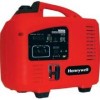Honeywell HW2000i Owners Manual - Page 32
Transporting Generator, Draining Fuel - extended run fuel tank
 |
UPC - 894190002193
View all Honeywell HW2000i manuals
Add to My Manuals
Save this manual to your list of manuals |
Page 32 highlights
Transporting Generator Transporting Generator Transporting Generator WARNING Hot engine or exhaust system can cause serious burns or fires. Cool generator completely before transporting or storing. Do not leave generator inside vehicle during high temperatures. This could cause the fuel to vaporize and possibly explode. Do not overfill the tank before transporting. Do not drive across rough terrain while transporting the generator as this may cause fuel leakage. Drain fuel from generator. Do not operate generator while it is in a vehicle. When transporting the generator: 1. Press the engine control switch to the OFF position. 2. Turn the fuel valve to the OFF position. 3. Turn the fuel cap vent to the OFF position (HW1000i model only). 4. Keep the generator level to prevent fuel spillage. NOTICE To avoid damage to the generator, take care not to drop or strike the generator when transporting. Do not place heavy objects on the generator. Storing Generator NOTICE Follow service procedures for preparing generator for storage. Inadequate or improper care of generator can result in damage to generator components and will void limited warranty. Before storing the generator for extended period of time: • Be sure storage area is free of excessive humidity and dust. • Refer to Table 8 for recommended preparation procedures. Storage Time Recommended Preparation Less than 1 month No preparation required. 1 to 2 months Fill fuel tank with fresh gasoline and add gasoline conditioner*. More than 2 months See procedure below. TABLE 8. Recommended Service Procedures Based on Storage Time * Use gasoline conditioners formulated to extend storage life. Contact authorized generator dealer for conditioner recommendations. To prepare the generator for long-term storage:. DANGER Fuel and its vapors are extremely flammable and explosive under certain conditions. • NEVER smoke or allow flames or sparks near generator or where gasoline is stored. 1. Drain the fuel into a suitable container (see page 26). 2. Change the engine oil (see page 19). 3. Remove the spark plug. Add a tablespoon of clean engine oil into spark plug hole. 4. Place a rag over the spark plug hole and pull the recoil starter handle slowly to turn engine and distribute the oil. Reinstall the spark plug. At this point, the piston is coming up on its compression stroke and both intake and exhaust valves are closed. Storing engine in this position will help to protect it from internal corrosion. Draining Fuel 1. Turn the fuel valve to the OFF position. OFF FUEL ON p/n 101592A OFF FIGURE 43: Fuel Valve - OFF position 2. Run the engine until it stops due to lack of fuel. 3. Place a suitable container adjacent to the generator. 4. Remove the fuel cap and drain all the fuel into a con- tainer. FIGURE 44: Draining Fuel 5. When ready to put the generator back into operation, refill with fresh fuel (see page 22). 26 www.honeywellgenerators.com HW1000i / HW2000i Inverter Generator Owner's Manual















